1 May 1997 2001 → 271 seats, 34.4% 336 seats, 41.9% 273 343 Start date May 1, 1997 Location United Kingdom | Turnout 71.3% (6.4%) 336 seats, 41.9% 20 seats, 17.8% 343 18 End date 1997 | |
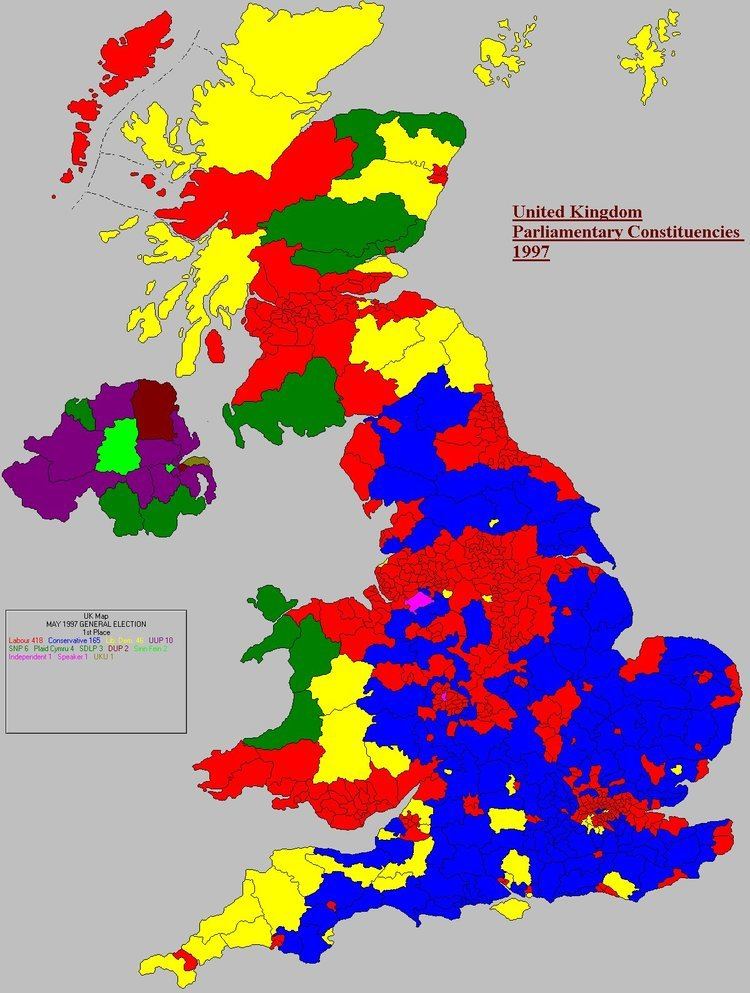 | ||
Winner Tony Blair | ||
The United Kingdom general election of 1997 was held on 1 May 1997, five years after the previous election on 9 April 1992, to elect 659 members to the British House of Commons. Under the leadership of Tony Blair, the Labour Party ended its 18 years in opposition and won the general election with a landslide victory, winning 418 seats, the most seats the party has ever held. The election saw a huge 10.2% swing from the Conservatives to Labour on a national turnout of 71% and would be the last national vote where turnout exceeded 70% until the 2016 EU Referendum was held nineteen years later. Blair, as a result, became Prime Minister of the United Kingdom of Great Britain and Northern Ireland, a position he held until his resignation in 2007.
Contents
- Overview
- Timing
- Campaign
- Conservative campaign
- Labour campaign
- Liberal Democrat campaign
- Notional 1992 results
- Results
- Conservative Ministers who lost their seats
- Other Conservative MPs who lost their seats
- Liberal Democrats who lost their seats
- Social and Democratic Labour Party MP who lost his seat
- Democratic Unionist MP who lost his seat
- Referendum Party MP who lost his seat
- Post election events
- Internet coverage
- References
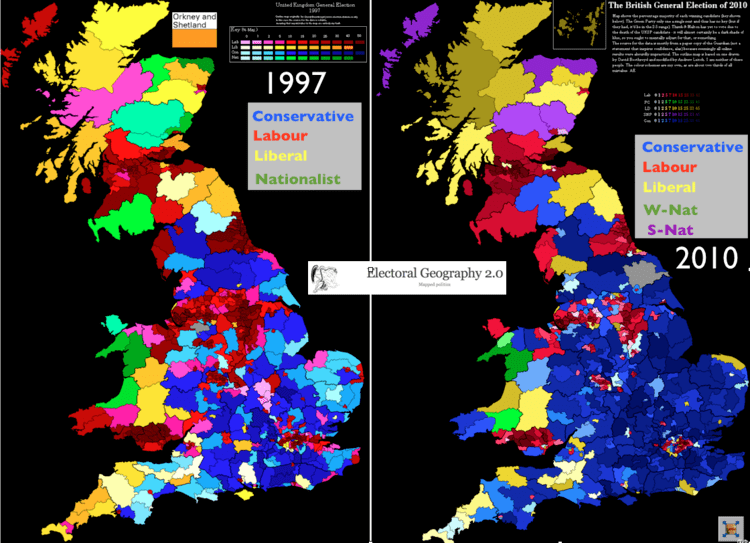
Under Blair's leadership, the Labour Party had adopted a more centrist policy platform under the name 'New Labour'. This was seen as moving away from the traditionally more left-wing stance of the Labour Party. Labour made several campaign pledges such as the creation of a National Minimum Wage, devolution referendums for Scotland and Wales and promised greater economic competence than the Conservatives, who were unpopular following the events of Black Wednesday in 1992. The Labour campaign was ultimately a success and the party returned an unprecedented 418 MPs and began the first of three consecutive terms for Labour in government. However, 1997 remains the last election in which Labour had a net gain of seats. A record number of women were elected to parliament, 120, of whom 101 were Labour MPs. This was in part thanks to Labour's policy of using all-women shortlists.
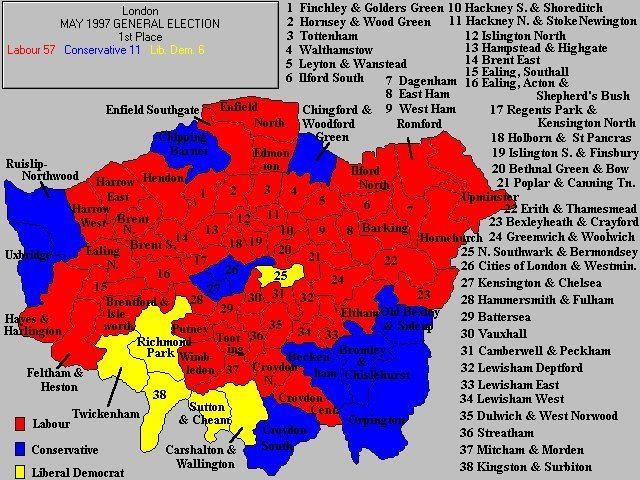
The Conservative Party was led by incumbent Prime Minister John Major and ran their campaign emphasising falling unemployment and a strong economic recovery following the early 1990s recession. However, a series of scandals, party disunity over the European Union, the events of Black Wednesday and a desire of the electorate for change after 18 years of Tory rule all contributed to the Conservatives' worst defeat since 1906, with only 165 MPs elected to Westminster, as well as their lowest percentage share of the vote since 1832. The party was left with no seats whatsoever in Scotland or Wales, and many key Conservative politicians, including Defence Secretary Michael Portillo, Foreign Secretary Malcolm Rifkind, Trade Secretary Ian Lang, Scottish Secretary Michael Forsyth and former ministers Edwina Currie, Norman Lamont, David Mellor and Neil Hamilton all losing their parliamentary seats. However, future Prime Minister Theresa May was elected to the safe Conservative seat at Maidenhead, and future Speaker John Bercow in the seat at Buckingham. Following the defeat, the Conservatives began their longest continuous spell in opposition in the history of the present day (post–Tamworth Manifesto) Conservative Party, and indeed the longest such spell for any incarnation of the Tories/Conservatives since the 1760s, lasting 13 years.
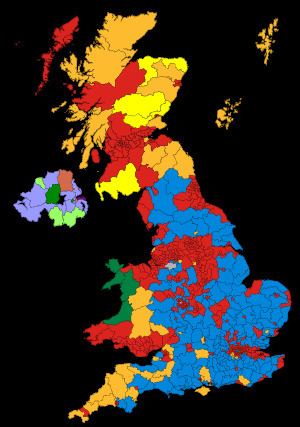
The Liberal Democrats, under Paddy Ashdown, returned 46 MPs to parliament, the most for any third party since 1929 and more than double the amount of seats they got in 1992, despite a drop in popular vote. The Scottish National Party (SNP) returned 6 MPs, double their total in 1992.

As with all general elections since the early 1950s, the results were broadcast live on the BBC; the presenters were David Dimbleby, Peter Snow and Jeremy Paxman.
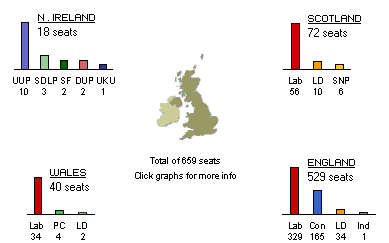
Overview
The British economy had been in recession at the time of the 1992 election, which the Conservatives had won, and although the recession had ended within a year, events such as Black Wednesday had tarnished the Conservative government's reputation for economic management. Labour had elected John Smith as its party leader in 1992, but his death from heart attack in 1994 led the way for Tony Blair to become Labour leader. Blair brought the party closer to the political centre and abolished the party's Clause IV in their constitution, which had committed them to mass nationalisation of industry. Labour also reversed its policy on unilateral nuclear disarmament and the events of Black Wednesday allowed Labour to promise greater economic management under the Chancellorship of Gordon Brown. A manifesto, entitled New Labour, New Life For Britain was released in 1996 and outlined 5 key pledges:
Disputes within the Conservative government over European Union issues, and a variety of "sleaze" allegations had severely affected the government's popularity. Despite the strong economic recovery and substantial fall in unemployment in the four years leading up to the election, the rise in Conservative support was only marginal with all of the major opinion polls having shown Labour in a comfortable lead since late 1992.
Timing
The previous Parliament first sat on 29 April 1992. The Parliament Act 1911 required at the time for each Parliament to be dissolved before the 5th anniversary of its first sitting, therefore the latest date the dissolution and the summoning of the next parliament could have been held on was 28 April 1997. The 1985 amendment of the Representation of the People Act 1983 required that the election must take place on the 11th working day after the deadline for nomination papers, which in turn must be no more than six working days after the next parliament was summoned. Therefore, the latest date the election could have been held on was 22 May 1997 (which happened to be a Thursday). British elections (and referendums) have been held on Thursdays by convention since the 1930s, but can be held on other working days.
Campaign
Prime Minister John Major called the election on Monday 17 March 1997, ensuring the formal campaign would be unusually long, at six weeks (Parliament was dissolved on 8 April). The election was scheduled for 1 May, to coincide with the local elections on the same day. This set a precedent, as the three subsequent general elections have also been held alongside the May local elections. The Conservatives argued that a long campaign would expose Labour and allow the Conservative message to be heard. However, Major was accused of arranging an early dissolution to protect Neil Hamilton from a pending parliamentary report into his conduct: a report that Major had earlier guaranteed would be published before the election.
Conservative campaign
The Conservatives started low in the polls, and had experienced great difficulties over the past 5 years, with polling often putting it some 40 points adrift of Labour. Major hoped that a long campaign would expose Labour's "hollowness" and the Conservative campaign emphasised stability, as did its manifesto title 'You can only be sure with the Conservatives'. However, the campaign was beset by deep set problems, such as the rise of James Goldsmith's Referendum Party, advocating a referendum on continued membership of the European Union. The Party threatened to take away many right-leaning voters from the Conservatives. Furthermore, about 200 candidates broke with official Conservative policy to oppose British membership of the single European currency. Major fought back, saying: "Whether you agree with me or disagree with me; like me or loathe me, don't bind my hands when I am negotiating on behalf of the British nation." The moment is remembered as one of the defining, and most surreal, moments of the election.
Meanwhile, there was also division amongst the Conservative cabinet, with Chancellor Kenneth Clarke describing the views of Home Secretary Michael Howard on Europe as "paranoid and xenophobic nonsense". The Conservatives also struggled to come up with a definitive theme to attack the Labour Party, with some strategists arguing for an approach which castigated Labour for "stealing Tory clothes" (copying their positions), with others making the case for a more confrontational approach, stating that "New Labour" was just a façade for "old Labour". The New Labour, New Danger poster, which depicted Tony Blair with demon eyes, was an example of the latter strategy. Major veered between the two approaches, which left Conservative Central Office staff frustrated. As Andrew Cooper explained: "We repeatedly tried and failed to get him to understand that you couldn't say that they were dangerous and copying you at the same time." In any case, the campaign failed to gain much traction, and the Conservatives went down to a landslide defeat at the polls.
Labour campaign
Labour ran a slick campaign, which emphasised the splits within the Conservative government, and argued that the country needed a more centrist administration. Labour ran a centrist campaign that was good at picking up dissatisfied Tory voters, particularly moderate and suburban ones. Tony Blair, highly popular, was very much the centrepiece of the campaign, and proved a highly effective campaigner. The Labour campaign was reminiscent of those of Bill Clinton for the US Presidency, focusing on centrist themes, as well as adopting policies more commonly associated with the right, such as cracking down on crime and fiscal responsibility. The influence of political 'Spin' came into great effect for New Labour at this point, as media centric figures such as Alastair Campbell and Peter Mandelson provided a clear cut campaign, and establishing a relatively new political brand "New Labour' with enviable success.
Liberal Democrat campaign
The Liberal Democrats had suffered a disappointing performance in 1992, but they were very much strengthened in 1997 due to potential tactical voting between Labour and Lib Dem supporters in Tory marginal constituencies, particularly in the south - particularly given their share of the vote decreased whilst their number of seats nearly doubled. The Lib Dems promised to increase education funding paid for by a 1p increase in income tax.
Notional 1992 results
The election was fought under new boundaries, with a net increase of eight seats compared to the 1992 election (651 to 659). Changes listed here are from the notional 1992 result, had it been fought on the boundaries established in 1997. These notional results were calculated by Colin Rallings and Michael Thrasher and were used by all media organisations at the time.
Results
Labour won a landslide victory with their largest parliamentary majority (179) to date. On the BBC's election night programme Professor Anthony King described the result of the exit poll, which accurately predicted a Labour landslide, as being akin to "an asteroid hitting the planet and destroying practically all life on Earth". After years of trying the Labour Party had convinced the electorate that they would usher in a new age of prosperity—their policies, organisation and tone of optimism slotting perfectly into place.
Labour's victory was largely credited to the charisma of Tony Blair and a Labour public relations machine managed by Alastair Campbell. Between the 1992 election and the 1997 election there had also been major steps to modernise the party, including scrapping Clause IV that had committed the party to extending public ownership of industry. New Labour had suddenly seized the middle ground of the political spectrum, attracting voters much further to the right than their traditional working class or left-wing support. In the early hours of 2 May 1997 a party was held at the Royal Festival Hall, in which Blair stated that "a new dawn has broken, has it not?".
The election was a crushing defeat for the Conservative Party, with the party having its lowest percentage share of the popular vote since 1832 under the Duke of Wellington's leadership, being wiped out in Scotland and Wales. A number of prominent Conservative MPs lost their seats in the election, including Michael Portillo, Malcolm Rifkind, Edwina Currie, David Mellor, Neil Hamilton and Norman Lamont. Such was the extent of Conservative losses at the election that Cecil Parkinson, speaking on the BBC's election night programme, joked upon the Conservatives winning their second seat that he was pleased that the subsequent election for the leadership would be contested.
The Liberal Democrats more than doubled their number of seats thanks to the use of tactical voting against the Conservatives. Although their share of the vote fell slightly, their total of 46 MPs was the highest since David Lloyd George led the party to 59 seats in 1929.
The Referendum Party, which sought a referendum on the United Kingdom's relationship with the European Union, came fourth in terms of votes with 800,000 votes mainly from former Conservative voters, but won no seats in parliament. The six parties with the next highest votes stood only in either Scotland, Northern Ireland or Wales; in order, they were the Scottish National Party, the Ulster Unionist Party, the Social Democratic and Labour Party, Plaid Cymru, Sinn Féin, and the Democratic Unionist Party.
In the previously safe seat of Tatton, where incumbent Conservative MP Neil Hamilton was facing charges of having taken cash for questions, the Labour and Liberal Democrat Parties decided not to field candidates in order that an independent candidate, Martin Bell, would have a better chance of winning the seat, which he did with a comfortable margin.
The result declared for the constituency of Winchester showed a margin of victory of just two votes for the Liberal Democrats. The defeated Conservative candidate mounted a successful legal challenge to the result on the grounds that errors by election officials (failures to stamp certain votes) had changed the result; the court ruled the result invalid and ordered a by-election on 20 November which was won by the Liberal Democrats with a much larger majority, causing much recrimination in the Conservative Party about the decision to challenge the original result in the first place.
This election marked the start of Labour government for the next 13 years until the formation of the Conservative-Liberal Democrat coalition in 2010.
All parties with more than 500 votes shown. Labour total includes New Labour and "Labour Time for Change" candidates; Conservative total includes candidates in Northern Ireland (excluded in some lists) and "Loyal Conservative" candidate.
The Popular Unionist MP elected in 1992 died in 1995 and the party folded shortly afterwards.
There was no incumbent Speaker in the 1992 election.
Conservative Ministers who lost their seats
Other Conservative MPs who lost their seats
Constituencies given are those contested in 1997, rather than those held prior to the election - Norman Lamont, for example, had previously represented Kingston upon Thames in London.
Liberal Democrats who lost their seats
Social and Democratic Labour Party MP who lost his seat
Democratic Unionist MP who lost his seat
Referendum Party MP who lost his seat
Post election events
The poor results for the Conservative Party led to infighting, with the One Nation, Tory Reform Group, and right wing Maastricht rebels blaming each other for the defeat. Party chairman Brian Mawhinney said on the night of the election, that it was due to disillusionment with 18 years of Conservative rule. John Major resigned as party leader, saying "When the curtain falls, it is time to leave the stage".
Despite receiving fewer votes than in 1992, the Liberal Democrats more than doubled their number of seats and won their best general election result since 1929 under David Lloyd George's leadership. Paddy Ashdown's continued leadership had been vindicated, despite a disappointing 1992 election, and they were in a position to build positively as a strong third party into the new millennium.
Internet coverage
With the huge rise in internet use since the previous general election, BBC News created a special website covering the election as an experiment for the efficiency of an online news service which was due for a launch later in the year.
